实用英语UNIT6教案
- 格式:doc
- 大小:64.50 KB
- 文档页数:7
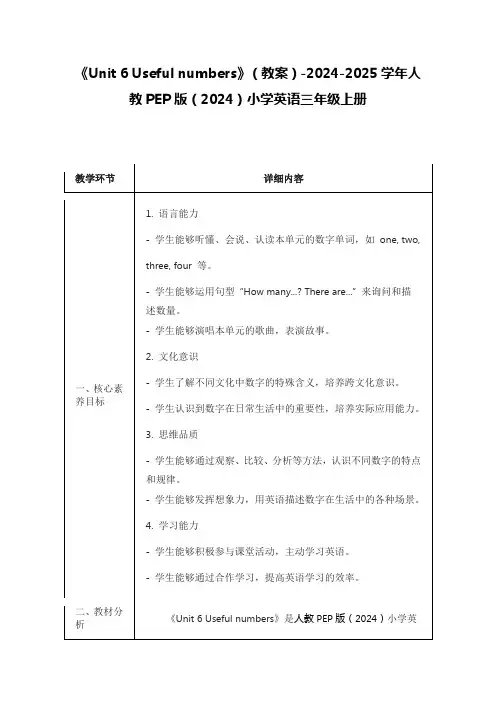
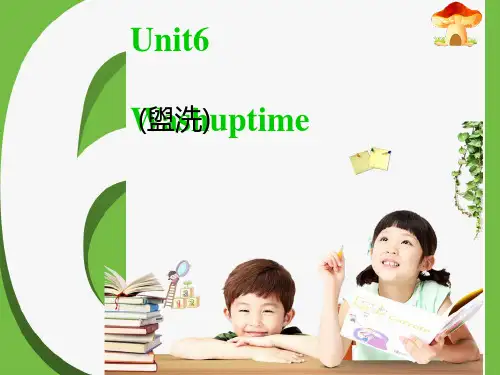
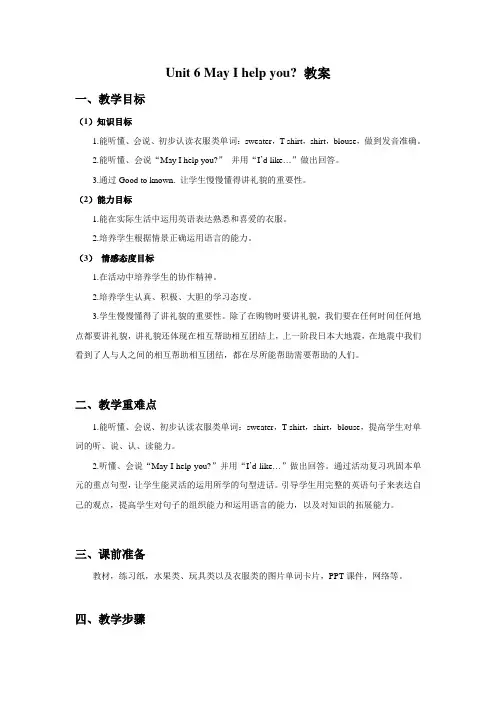
Unit 6 May I help you? 教案一、教学目标(1)知识目标1.能听懂、会说、初步认读衣服类单词:sweater,T-shirt,shirt,blouse,做到发音准确。
2.能听懂、会说“May I help you?”并用“I’d like…”做出回答。
3.通过Good to known. 让学生慢慢懂得讲礼貌的重要性。
(2)能力目标1.能在实际生活中运用英语表达熟悉和喜爱的衣服。
2.培养学生根据情景正确运用语言的能力。
(3)情感态度目标1.在活动中培养学生的协作精神。
2.培养学生认真、积极、大胆的学习态度。
3.学生慢慢懂得了讲礼貌的重要性。
除了在购物时要讲礼貌,我们要在任何时间任何地点都要讲礼貌,讲礼貌还体现在相互帮助相互团结上,上一阶段日本大地震,在地震中我们看到了人与人之间的相互帮助相互团结,都在尽所能帮助需要帮助的人们。
二、教学重难点1.能听懂、会说、初步认读衣服类单词:sweater,T-shirt,shirt,blouse,提高学生对单词的听、说、认、读能力。
2.听懂、会说“May I help you?”并用“I’d like…”做出回答。
通过活动复习巩固本单元的重点句型,让学生能灵活的运用所学的句型进话。
引导学生用完整的英语句子来表达自己的观点,提高学生对句子的组织能力和运用语言的能力,以及对知识的拓展能力。
三、课前准备教材,练习纸,水果类、玩具类以及衣服类的图片单词卡片,PPT课件,网络等。
四、教学步骤Step 1: Warm-up and review(1)Greeting(2)Ask and answerT: Look at the key words: how and what. Now I’ll ask you some questions.T: How are you?S: I’m fine, thank you.T: What do you like?S1: I like apples.T: What can you see?S2: I can see a pencil.(设计意图:通过复习本学期的相关知识点,为新知识的教授作铺垫)Step 2: Presentation and practise1. T: I want to buy something for Wang Bing. Who can ask me?S1: Can I help you?T: I’d like a jacket.课件出示单词卡片,让学生试着读出新单词jacket。
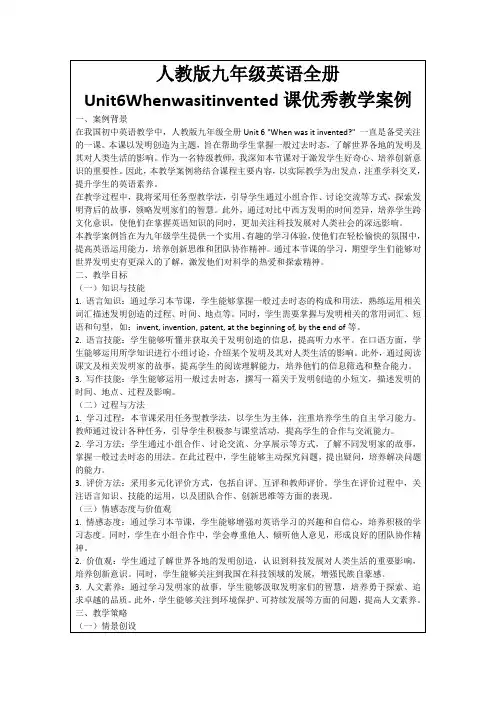
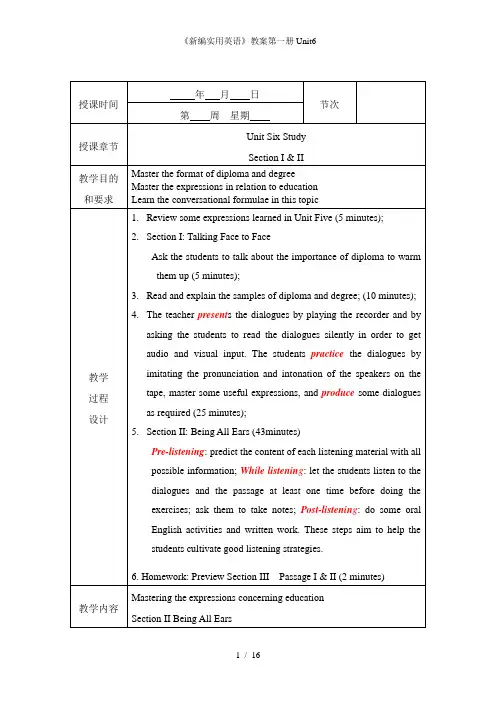
Unit SixStudyI. Objectives:By the end of this unit, the students should be able to1) read, discuss and translate diplomas and degrees in English,2) learn some expressions in talking about courses, diplomas, degrees, andcertificates in relation to their education,3) comprehend the two passages and master the useful expressions in them, and4) finish the exercises by themselves or with some help.II. IntroductionLead-in(导入): First, the students are asked to discuss the importance of diploma. Then their opinions are written down on the blackboard. Finally, the introductory remarks will be made by the teacher as follows:The diploma, degree, or other educational certificates are of utmost importance for those who want to seek a good job or receive a promotion. A lot of people have to study for a long time and many courses to get different degrees from the universities or colleges. In this unit you will learn how to converse about what degree you have and inquire about other people’s education.III. Teaching Procedures:Section I. Talking Face to FaceStep 1. Presentation:Read the following Samples of a diploma and a degree of bachelor.Sample 1翻译:Sample 2翻译:学士学位证书星华大学兹证明林小平被正式授予理科学士学位1999年7月17日校长签名:Topic-related Information--Names of MajorsComputer ScienceTelecommunication Engineering--Names of DepartmentsPostal Communication Management DepartmentComputer DepartmentTelecommunications Engineering DepartmentEconomics DepartmentFinance DepartmentHumanity & Social Science DepartmentBasic Courses Department--Data Bank1)The duly authorized officers hereby certify that …正式授权的高级官员在此证明…2)This is to certify…兹证明…3)Sb. has completed a course of study in …某人已修完了在…方面的课程。
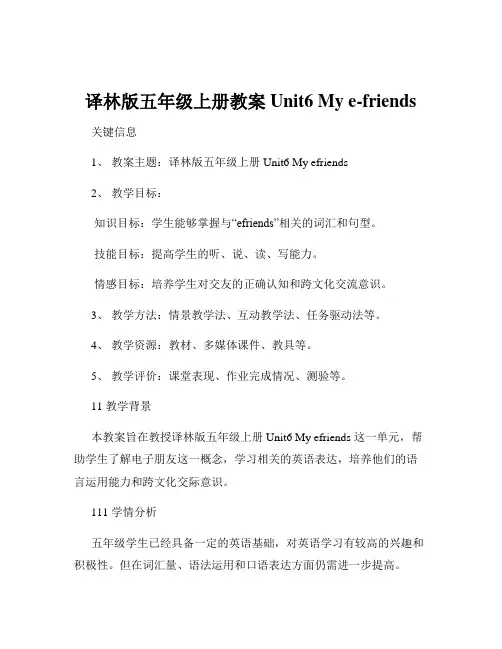
译林版五年级上册教案Unit6 My e-friends 关键信息1、教案主题:译林版五年级上册 Unit6 My efriends2、教学目标:知识目标:学生能够掌握与“efriends”相关的词汇和句型。
技能目标:提高学生的听、说、读、写能力。
情感目标:培养学生对交友的正确认知和跨文化交流意识。
3、教学方法:情景教学法、互动教学法、任务驱动法等。
4、教学资源:教材、多媒体课件、教具等。
5、教学评价:课堂表现、作业完成情况、测验等。
11 教学背景本教案旨在教授译林版五年级上册 Unit6 My efriends 这一单元,帮助学生了解电子朋友这一概念,学习相关的英语表达,培养他们的语言运用能力和跨文化交际意识。
111 学情分析五年级学生已经具备一定的英语基础,对英语学习有较高的兴趣和积极性。
但在词汇量、语法运用和口语表达方面仍需进一步提高。
112 教材分析本单元围绕“efriends”这一主题展开,通过对话、短文等形式呈现了相关的词汇和句型,内容贴近学生生活,具有较强的实用性和趣味性。
12 教学目标细化121 知识目标学生能够熟练掌握单词:efriend, country, send, email, live, study 等。
能够正确运用句型:Do you have an efriend? Yes, I do / No, I don't Where does he/she live? He/She lives in What subjects does he/she like?He/She likes122 技能目标能够听懂关于“efriends”的对话和短文,获取关键信息。
能够用所学句型进行简单的交流,介绍自己或他人的电子朋友。
能够正确书写与“efriends”相关的句子和短文。
123 情感目标培养学生乐于结交朋友、尊重不同文化的意识。
激发学生对英语学习的兴趣,增强学习自信心。
13 教学方法与策略131 情景教学法创设真实的情景,让学生在情景中感受和运用语言。
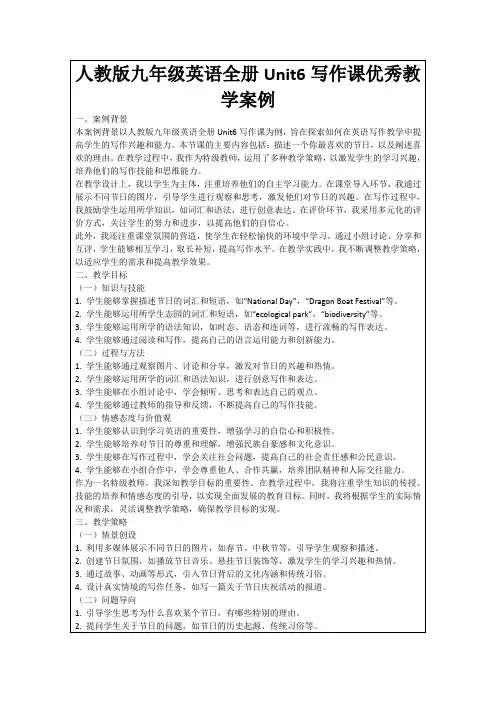

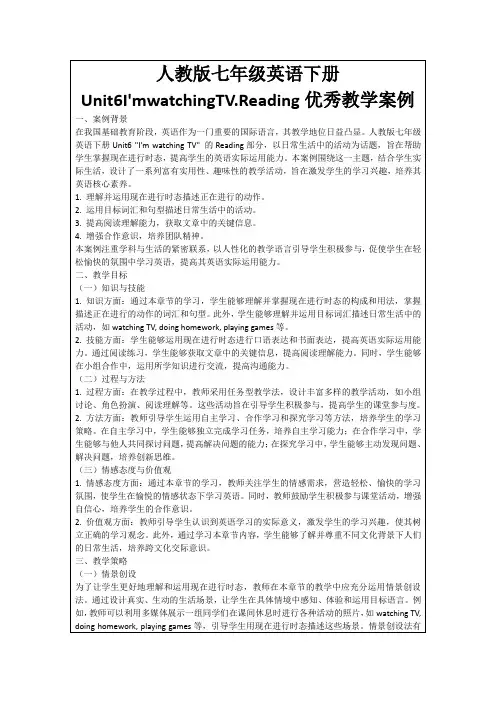
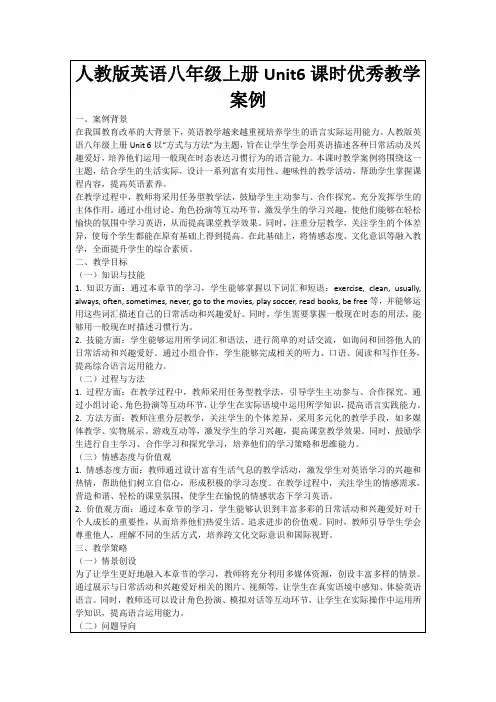

新编实用英语教案unit-6Unit 6 Olympics and SportsI.Teaching objectives1.Enlarge your vocabulary related to sports events and outdoor activities.2.Get some tips about the use of basic senescence structures.3.Practice designing and writing a sports event poster.4.Appreciate passages and complete exercises well.5.Practice talking about and comment on a sports event.6.Practice inviting friends to take part in outdoor activities.II. Key points1. Master the vocabulary and expressions about sports events and outdoor activities.2. Understand the passages3. Practice designing and writing a sports event poster.4. Practice talking about and comment on a sports event.5. Practice inviting friends to take part in outdoor activities.III. Difficult points1. Get some tips about the use of basic senescence structures.2. Practice designing and writing a sports event poster.3. Appreciate passages and complete exercises well.IV. Teaching methodology1.Task-based language teaching2.Direct methodV. Teaching proceduresSection I Talking Face to FaceImitating Mini-Talks1.Work in pairs. Practice the following mini-talks about sports events and outdoor activities.Acting out the Tasks2.Work in pairs and act out the tasks by following the above mini-talks.Key for reference:1.Task: Talk about the poster of an international women’s volleyball match.2.Task: Suggest going to watch a football match.3.Task: Talk about a weekend fishing contest.4.Task: Invite your friends to take part in a city long-distance race.5.Task: Suggest taking part in a summer camping trip.Studying Posters, Notices and Announcements3.Posters and notices for sports are common in newspapers, on campus and no notice boards. Read the following posters carefully and try to use the information to practice short dialogues.Following Sample Dialogues4.Read the following sample dialogues and try to perform your own tasks.Putting Language to Use5.Imagine you are meeting an English teacher from the USA at the airport. Read aloud the following dialogue with your partner by putting in the missing words.6.Imagine you are a new employee at a joint venture. Mr. Smith is the general manager there. You meet him for the first time at the company’s canteen. Fill in the blanks according to the clues given in the brackets. Then act it out with your partner. Section II Being All EarsLearning Sentences for Workplace Communication1.Listen to 10 sentences for workplace communication cross-referenced with their Chinese translations.Script: (e.g) 1. Haven’t you seen the poster of a weekend cycling?2. That’ll be a great way to kill the weekend.3. Are you going to watch the swimming meet?4. That’ll surely be a close game.5. There is going to be a chess game at the Students’Center this Saturday.2.Listen to the following sentences for workplace communication in Column A and match each one with its Chinese version in Column B.3.Listen to 6 sentences for workplace communication and choose their right responses. Handling a Dialogue4.Listen to a dialogue and decode the message by finding out the correct choices in the brackets according to what you have heard.Understanding a Short Speech/Talk5.Now listen to a short speech/talk and fill up the blanks according to what you have heard.The words in brackets will give you some hints.6.Listen to the speech/talk again and complete the information in Column A with the right choices in Column B.Section III Trying Your HandPracticing Applied Writing1.Read the following two sample announcements/posters and learn to write your own.2.Translate the following poster into Chinese, using the data bank in the Workbook for reference.3.Write an English poster according to the information given in Chinese.4.Write an English poster according to the information given in Chinese.Writing Sentences and Reviewing Grammar5.Put in the proper tense form of the verb according to the adverbial or clause in each of the sentences.6.Correct the errors in the following sentences.7.Translate the following sentences into English.1)There will be an excellent tennis match tomorrow. I have got the tickets already.2)Xiao Li told me that he had taken part in the tug-of-war match that afternoon.3) A modern gymnasium will have been built at our university by this time next year.4)When / while the sportsmen were swimming, we were cheering for them loudly.5)Sports do a lot of good to the health. So I have been doing exercise since I wasyoung.Write and Describe a Picture8. Write a short passage of about 100 words to tell a story or about an event related to the picture given below. Some useful words and phrases have been provided to help you. You may start the passage with the sentence: Fishing is my favorite sport.Section IV Maintaining a Sharp EyePassage oneInformation Related to the Reading Passagenguage Points:A.Explanation of Difficult Sentences1)When the Beijing 2008 Olympic Games emblem “Chinese Seal, Dancing Beijing” was first presented to the International Olympic Committee, the IOC officials all gave it high praise, saying it was the best emblem ever designed.Analysis: This complex sentence is introduced by when-clause, with +ing-clause as the complement to the main clause“the IOC officials all gave it high praise”.2)The Beijing 2008 Olympic Games emblem is filled with Beijing’s hospitality and hopes, and carries the commitment made to the Olympic Movement by a country that has a population of 1.3 billion and by a nation with both ancient civilization and modern culture.Analysis: Note that the word commitment is followed by an attributive with “that was”omitted; a country is followed by an appositive introduced by that, and both a country and a nation are part of by in the passive voice structure.3)“Dancing Beijing” is a symbol of trust and an expression of self confidence, standing for the promise that Beijing—the host city of the Beijing 2008 Olympic Games—has made to the world and to all mankind.Analysis: The host city of the Beijing 2008 Olympic Games is the inserted element, splitting the attributive clause introduced by that.4)Olympic Games function as the stage where heroes are made, records broken and medals earned.Analysis: An attributive introduced by where is used here. Note omission is used in the attributive. The auxiliary verb are is omitted in records broken and medals earned when similar structures occur on the run.5)The open arms in the emblem say that China is opening its arms to welcome the rest of the world to join the Olympics, a celebration of “peace, friendship and progress of mankind”.Analysis: a celebration of “peace, friendship and progress of mankind”is the appositive of the Olympics.6)“is it not a joy to have friends come from afar?”Analysis: this is a quote from Confucius.7)Come to Beijing, take a good look at the historical heritages of China’s capital city, and feel the pulse of the country’s modernization.Analysis: Imperative structure verb + verb + and verb is used here to encourage people to do something.B.Important Words1)present v.give or hand over something to somebody2)hospitality n. friendly and generous reception and entertainment of guests or strangers, esp. in one’s own home3)commitment n.things one has promised to do; pledge4)intensively ad.Concentrating all one’s effort on a specific area5)passion n. strong feeling, eg. Of hate, love or anger6)symbolize v. be a symbol of something7)represent v.stand for8)vitality n.persistent energy; liveliness or vigor9)historical a.concerning past events2.Passage Translation3.Read and Think: Answer the following questions according to the passage.4.Read and Complete1)Complete each of the following statements with words or phrases from the passage.2)Fill in the blanks with the proper words or expressions given below, changing theform if necessary.5.Read and Translate6.Read and SimulatePassage twoInformation Related to the Reading Passagenguage Points:A.Explanation of Difficult Sentences1)Tonight, we come to the end of 16 glorious days which we will cherish forever. Analysis: which introduces a relative clause. Note in translation, the sentence is cut into two separate parts.2)Thank-you to the people of China, all the wonderful volunteers and BOCOG! Analysis: This is an elliptical sentence, the full sentence will be “I would like to say thank-you to…”. In speeches, another commonly used sentence expressing thanks is (my) thanks goes to…3)As we celebrate the success of these Games, let us all together wish the best for the talented athletes who will soon participate in the Paralympics Games.Analysis: As introduces an adverbial of time, meaning when. Wish the best for sb. means.4) The Olympic spirit lives in the warm embrace of competitive rivals from nations in conflict.Analysis: The prepositional phrase in conflict is the post modifier of nations, meaning those nation are not on a peaceful and friendly terms.B. Important Words1)cherish v. hold dear2)awe v. inspire with wonder3)talent n. a special aptitude or faculty4)marvel n. feel and show great surprise or wonder (followed by at or that-clause)5)witness v. see something happen6)competitive a. involving in competition7)exceptional a. involving in competition8)assemble v. gather together, collect2.Passage Translation3.Read and Judge: True/False4.Read and Translate: Translate the following sentences into Chinese.1)Every July, graduates come to the end of their college life, which they will cherishforever.2)The Internet offers people more chances of learning about the world.3)Now, in accordance with tradition, I declare the Winter Olympic Games open!4)She has been reading all the necessary information ever since in order to be able toparticipate in that project.5)The group awed us with their talent, teamwork and achievement.6)Every year CCTV chooses “Moving China Top Ten” as the true role models fromacross the whole nation.7)The past two decades have witnessed great changes in information technology. Section V Appreciating Culture Tip(Open)。
牛津译林Unit 6 Keep our city clean优质教案一、教学内容本节课我们将学习牛津译林版英语教材Unit 6 Keep our city clean。
具体内容包括:第一部分,即Reading部分,着重讲解1a1d,让学生解城市污染问题以及如何保护环境;第二部分,即Grammar部分,详细解析2a2d,让学生掌握一般现在时用法。
二、教学目标1. 让学生理解并掌握本课词汇和句型,如:rubbish, dirty, clean, recycle等。
2. 培养学生运用一般现在时描述日常生活中保护环境行为。
3. 提高学生环保意识,使他们认识到保护环境重要性。
三、教学难点与重点1. 教学难点:一般现在时用法,以及如何用所学词汇和句型描述保护环境行为。
2. 教学重点:词汇和句型掌握,以及环保意识培养。
四、教具与学具准备1. 教具:PPT,展示城市污染和环保图片;黑板,用于板书。
2. 学具:课本,练习本,用于课堂学习和随堂练习。
五、教学过程1. 导入:通过展示城市污染图片,引发学生对环保关注,进而引入本课主题。
步骤:展示图片,提问:“Wha t can you see in the pictures?”,引导学生回答并引出本课主题。
2. 阅读:让学生阅读1a1d部分,解城市污染问题和环保方法。
步骤:让学生自主阅读,然后回答问题,如:“How can we keep our city clean?”,引导学生掌握文章内容。
3. 语法:讲解2a2d部分,让学生掌握一般现在时用法。
步骤:通过例句和练习,让学生理解并运用一般现在时。
4. 实践情景引入:让学生分组讨论,讨论如何在生活中保护环境。
步骤:分组讨论,每组提出一个环保建议,并进行分享。
5. 例题讲解:针对本节课重点和难点,进行例题讲解。
步骤:讲解例题,引导学生正确回答,并解释答案。
6. 随堂练习:让学生完成课后练习,巩固所学知识。
步骤:布置练习题,学生完成后,进行讲解。
新编实用英语综合教程1-u n i t6-教案
用心整理的精品word文档,下载即可编辑!!
教案首页
精心整理,用心做精品1
用心整理的精品word文档,下载即可编辑!!
课堂组织
教案内容
精心整理,用心做精品2
用心整理的精品word文档,下载即可编辑!!
精心整理,用心做精品3
用心整理的精品word文档,下载即可编辑!!
精心整理,用心做精品4
用心整理的精品word文档,下载即可编辑!!
教案首页
精心整理,用心做精品5
用心整理的精品word文档,下载即可编辑!!
课堂组织
精心整理,用心做精品6
用心整理的精品word文档,下载即可编辑!!
教案内容
精心整理,用心做精品7
用心整理的精品word文档,下载即可编辑!!
精心整理,用心做精品8
用心整理的精品word文档,下载即可编辑!!
精心整理,用心做精品9
教案首页
课堂组织
教案内容
教案首页
课堂组织
教案内容。
Unit 6 Shopping and sightseeingAims of this unit:1. Improve listening and speaking skills2. Learn the words and phrases in the text3. Complete the exercises after the text4. Applied WritingFirst Two hours:Talking Face to Face & Being All EarsSection I Talking Face to Face1. Duty report3. Leading-in:Shopping adsSellers and manufacturers place a variety of shopping ads in newspapers and magazines, on the radio and television, to promote sales.Oral practice:1. Ask the students to say something about their impression on ads.2. Ask the students to write an ad to a newspaper to ask for an apartment.3. Ask the students to find a suitable restaurant from the newspaper.4. You want to buy some tri-colored glazed pottery at an arts and crafts shop.5. You are looking for a shirt of good quality at a Men’s Wear Department.6. You want to buy a computer and ask for a discount.4. Follow the Samples; read dialogues in roles (group work) Language points:date back 回溯至on sale 待售, 出售, 上市[美]廉价出售, 拍卖take your time 从容不迫5. Try to find useful patterns in the dialogues and translate them into Chinese, make up more sentencesUseful sentences:Some useful sentences:Excellent after-sales serviceFair prices to every customerChinese handicraftsDo you have anything particular in mind?I want to buy some souvenirs for my friends and relatives.How do you like this ring?Look around and see if you can find something you like. How about the tri-colored glazed pottery in Tang style?It’s very pleasing to the eye.What’s that in dollars?an arts and crafts shopI’d like a pair of leather shoes.What size, please?Anything I can do for you, sir?What brand do you need, please?This brand’s at 25 percent discount.More patterns and expressions for students to remember: We deal in TV sets, radios and the like.我们经营电视机、收音机以及诸如此类的商品。
Unit6Meet my family教学设计英语学科备课记录表姓名年级四学科英语时间教学课题PEP Unit6Meet my family A Let’s talk&Let’s count教学内容分析本课的教学主要是学习家庭成员人数的询问与回答方法,重点是能够听、说、读、写“How many…are there…?”。
并能根据一定的实际情况适当运用这一句型。
四年级学生在第二单元已经学过询问书本的数量的句型“How many books do you have?”,懂得用“How many……”询问数量;同时学生对家庭成员已经非常的了解,这些为本课时的学习打下了良好的知识和现实基础。
教学目标知识与技能:1、知识目标:能够听懂、会说本课对话。
2、能力目标:能听说认读本课句型“How many people are there in your family?”,并在实际生活中运用。
过程与方法:本节课主要以小组讨论法、直观演示法,通过运用游戏、活动、练习、对话交流等多种形式加以操练和巩固,让学生在自主合作、积极探究中掌握知识,从而突出重点,突破难点,掌握知识。
情感态度与价值观:培养学习英语的兴趣、勇于进行交际实践的能力,同伴间合作的能力。
了解英语国家的一些称谓方式。
重点1、教学重点:掌握“How many…are there…?”句型的用法。
难点2、教学难点:My family has7members./Who are they?/But that’s only 6.教具准备1.师准备人物称呼卡、全家福照片。
2.学生准备白纸作调查表,带家庭照片(或简笔画)。
教学步骤Step1.Warm-up/Review1.教师播放本册第二单元A部分Let’s chant录音,让学生跟着录音说唱。
2.T:How many books do you have?What are they?【预设】English books,Chinese books,notebooks,story-books,……【设计意图】以第二单元学过的吟唱的形式开始课程,既复习了以前的知识,又方便学生类比学习,便于新课的进行。